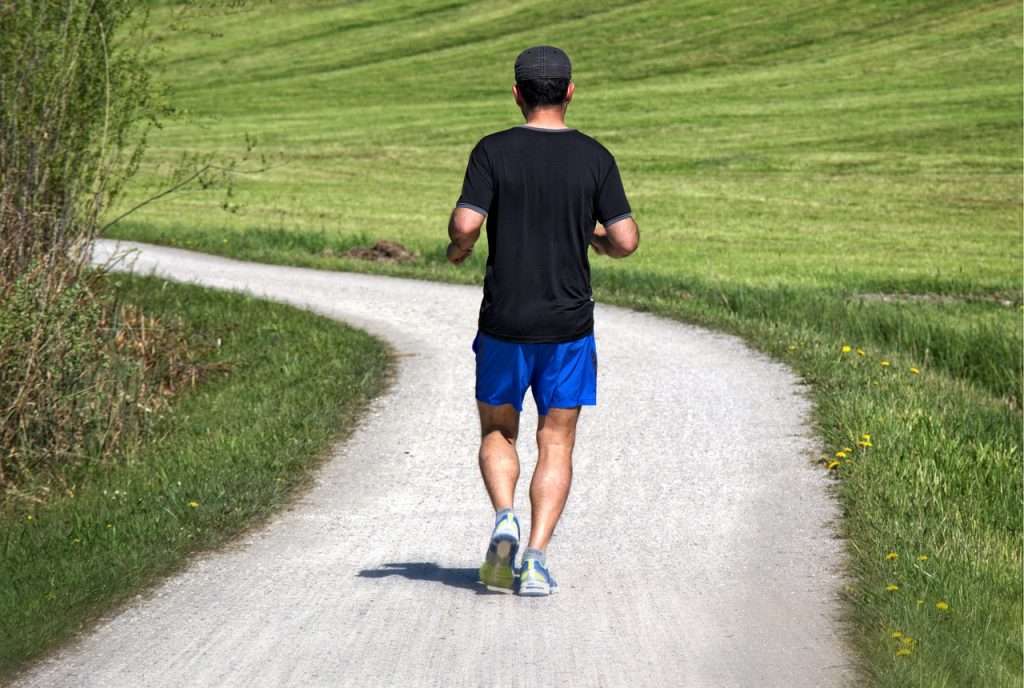Improving physical capability is a two factor equation. On the one hand, you need to train hard and offer the proper stimulus for the body to improve. The flip side of the coin, is rest and recovery. A less glamorous topic, certainly, and one that does not get the proper amount of attention.
The importance of recovery in running is unequivocal. To improve, you have to train smart and recover well. It is a requirement for faster running. Without sufficient rest to allow the body to adapt, there will be no improvement. Or, as exercise scientist Joe Friel put it:
“A hard workout only creates the potential for fitness. It’s realized when you recover afterwards.”
Joe Friel
A variety of factors determine how quickly a runner recovers from a hard session, or a hard week of training. Some of these are inherent and genetically determined. Recovery times also increase with age.
What many people tend to overlook is that the ability to recover is a trainable skill. In running, we turn type of type of run called recovery runs to work on this particular skill.
The Purpose of a Recovery Run
In the introduction to running training intensity, I put my ability to avoid injuries partly down to utilising recovery running as an intensity designation distinct from easy runs. The book Advanced Marathoning by Pfitzinger and Douglas echoes this sentiment. They note that runners must be conscious of how they approach recovery runs in order to allow let the body recover.
Exercise science has yet to determine a physiological benefit with regards to immediate recovery. Regardless, the run still serves several vital functions within the recovery process.
Increased Blood Flow
According to Pfitzinger and Douglas, recovery runs will increase blood flow through the muscles. Along with activating and warming up the muscles will reduces stiffness and muscle soreness.

Reduced Fatigue
Furthermore, as noted by Joe Friel, most advanced athletes report that “active recovery” reduces fatigue. Almost every experienced runner will give you similar anecdotal feedback. Friel also mentions that the recovery run stimulates adaption. And on this particular matter, there is science to back up the claim.
Improved Fitness
A scientific study published back in 2005, conducted at the University of Copenhagen in Denmark, discovered that a exercising in a pre-fatigued state will contribute to increase your fitness. A recovery run is exactly that; exercising in a pre-fatigued state.
In practical terms, this means is that a recovery run will boost your fitness. And perhaps even to same extent as longer and faster runs. Does this mean that we can skip all those other runs, and only do recovery runs?
Of course not! The fitness gained from a recovery run is entirely dependent on the work you put in during your more taxing workouts. The cumulative training load from these runs means that you go into a recovery workout in a fatigued state.
And that brings us back to the results of the study from Copenhagen. Because you’re going in pre-fatigued, recovery runs this will boost your fitness. And that’s despite the short duration and low intensity compared to a quality workout.
Recovery Runs Intensity
As we now know, recovery runs serve a vital function. Because of this, they are a crucial part of a well-made training plan. However, overdoing it on these days is a common mistake. Inevitably, trouble will follow.
Sure, you may get through a few weeks of going too hard during recovery sessions. But, eventually, the cumulative fatigue will catch up to you. Initially, you might struggle to get through workouts as prescribed. And, then, if you keep it up, your body is likely to break down and succumb to an overuse injury.
Recovery Run Perceived Effort
There is a saying that an easy run is a feeling, not a pace. When it comes to recovery runs, however, it can be difficult to gauge your intensity to perceived effort. Often times, you will be feeling sluggish before you even get started with your recovery workouts.

One important control measure of your perceived effort is the talk test. During a recovery run, you should never have trouble speaking in complete sentences. If you’re winded, and struggling to catch your breath, you’ve failed the talk test. In other words, you’re working too hard for a recovery run.
According to OLT’s intensity scale, your perceived effort during recovery runs should be “very easy” and, on a scale from 1 to 10, should be no higher than 2.
Intensity Control Through Pace
There are a couple of ways to ensure that you hit the right intensity during your recovery runs. By using a training pace estimation tool such as VDOT, you can calculate your easy-pace range. My recommendation is that you keep your pace on recovery days no faster than the slow end of this range.
Pfitzinger and Douglas suggest that recovery runs should be 2 minutes per mile (1 min 15 seconds per kilometre) slower than half marathon pace. Keep in mind that both these pace suggestions are for flat surfaces. Compared to your normal training pace for easy runs, your recovery run pace will vary.
Some days, when you’re feeling good and ready to go, your recovery run pace can approach your normal training pace. On other days, however—such as the day after a hard workout—your recovery pace will be significantly slower. Even by as much as 40 seconds per mile slower, or 30 seconds per kilometre.
Heart Rate Monitoring For Intensity Control
In my opinion, a heart rate monitor is the most effective way to control your recovery running intensity. This way, you can be sure that your average pulse does not exceed the recommended 72% of your Maximum Heart Rate (HR Max).
You can also use Heart Rate Reserve (HRR) to calculate your upper recovery run HR limit. Subtract your resting heart rate from your maximum heart rate. Calculate 70% of your HRR, and then add back your resting heart rate. Depending on your resting heart rate and HR Max, the result will be a little lower or higher than calculating straight from HR Max.

When I first started wearing a HR monitor, I was shocked by how much I had to slow down on recovery days. And keeping the readings in the recommended range was impossible when running uphill. However, it was the HR monitor that taught me the correct intensity of a recovery run.
After using HR readings as a guideline, most runners develop a feel for the proper recovery intensity. Some days, you will feel good and will run near the upper HR limit. Other days, however, you will feel stiff and sore, and your beats per minute will be lower on account of muscular fatigue.
How Long Is a Recovery Run?
Another interesting point of discussion is the distance you should run on your recovery days. Different coaches and scientists have differing opinions on this matter.
Renowned coach Tom “Tinman” Schwartz for instance, suggests recovery runs should be 10-15% of your weekly distance. Tinman reasons that adding mileage to your recovery runs results in improved strength. And, he continues, shorter recovery runs might give your legs pop but leave you performing worse on race day.
For moderate to high mileage runners, this number will be very high. A more traditional approach is to keep these runs between 8-12 kilometres. Another method is to stick to time, with 45 minutes to an hour being the standard guideline.
Focus on Time on Feet
My recommendation for runners who are adding in recovery runs to improve recovery and increase mileage is to start conservatively. Begin with 30 minutes, and increase the duration as you notice a positive physical response from the extra stimulus.
Adding too much load, too soon, defeats the purpose. As your body adjusts to the new training load, you can increase the duration of these runs towards Tinman’s recommendation.
Other Things to Note About The Recovery Run
To optimise the effect of a recovery run, you should keep a couple of points in mind.
Maintain Good Running Form
A challenge during recovery runs can be to maintain proper running form. Because of the slower pace, it is easy to slump down, and run in a hunched over fashion. It is critical to avoid this mistake, lest you end up enforcing bad habits. In fact, if you find it challenging to maintain proper form during your recovery run, a walk may be a better option.
Soft Surfaces Are Good For Recovery Runs
A softer surface are less taxing on the muscles than pavement. If possible, it is beneficial to stick to trails or similarly forgiving surfaces during recovery runs. Grass, for instance, is particularly suited for recovery running. Just remember not to get caught up with the pace!

Hills Are Bad For Recovery Runs
Conversely, hills are strenuous for the body. Going uphill requires extra effort, while downhills give the muscles extra pounding. Stick to a flat course to ensure optimal recovery response.
Recovery Run Frequency
How often you should be doing recovery runs depends on the number of times a week you run. Remember the first part of the equation in the opening paragraph. Stress plus rest equals growth. Focusing on rest without stressing your body will not yield results. To recover properly, you need to tax your body in a way that necessitates recovery.
For runners who run less than five times per week, recovery runs are not a necessary part of the training plan. This is simply because you get enough rest during a recovery day when you don’t run.
Instead, you are better off focusing on improving aerobic capacity through easy running on non-workout days. Once you start running five times a week or more, however, recovery runs become an essential part of your routine.
A rule of thumb is that for every five runs, at least one, preferably two, should be proper recovery runs. That means staying within the recovery run intensity designation. Avoid creeping up into easy run territory if recovery is the main purpose.
Timing Your Recovery Runs
The timing of a recovery run is also essential to maximise its effects. Ideally, you want to follow the hard-easy principle and add in the recovery run the day after a hard run.
Another possibility is to add in a recovery session in the evening after doing a morning workout. You want to experiment to figure out what works best for you. However, to reap the full rewards, you should always try to get in a recovery run no longer than 24 hours after a hard effort.
When Does a Full Rest Day Make Sense?
Slow runs can both aid recovery, and increase your fitness level. However, sometimes a full rest day will make more sense. If you’re feeling exhausted, either mentally, physically or both, full rest is a better option than a recovery run.
Adding a little bit of load to stimulate extra training adaptions is tempting. But remember that even a slow run adds additional load.
Rest is just as important a part of becoming a better runner as running. So when your body tells you that it needs space to recover, make the necessary space for rest days to get over lingering fatigue. And if you do decide to go out, remember to stick to a comfortable and conversational pace.
Like this?
Let me know by sending me an email at lc@run161.com.
